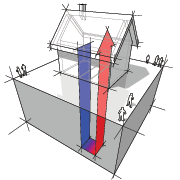 Any air conditioning system works by removing heat from your home, but a geothermal installation removes that heat using less energy. It does this by utilizing the constant temperatures found a few feet below ground.
Any air conditioning system works by removing heat from your home, but a geothermal installation removes that heat using less energy. It does this by utilizing the constant temperatures found a few feet below ground.
Unlike the hot springs or geysers that the term “geothermal” may bring to mind, these constant subterranean temperatures are found nearly everywhere. If you want a super efficient cooling system, a geothermal installation is the way to go.
How it works
The key to geothermal systems are a loop of liquid-filled pipes. The details of how they are set up depends on the characteristics of the land you have available. Horizontal layouts can be less costly to install if you have sufficient land to bury pipes via trenching, or more compact vertical layouts can be installed by drilling. If suitable water sources are available, they can host a submerged coil of pipes or be utilized directly with an open-loop system.
Whatever the geothermal setup, the pipes run into the home to interface with the geothermal air conditioner. Its refrigerant system removes heat from the home using the same method as standard air conditioners, but then transfers the heat to the water in the pipes instead of the exterior air. The loop of pipe ensures that any heat the water gains is transferred to the ground by the time it returns to the air conditioner.
Why it’s more efficient
Unlike standard air conditioning systems that have to transfer the heat removed from the home to the hot exterior air, geothermal installations allow it be transferred to constantly cool water. This takes much less energy. They also contain devices that allow them to work as water heaters by transferring heat to water for use in your home with no additional energy use. In winter, they can provide super efficient heating by working in reverse to transfer heat from the ground to your home.
If you’re looking for more expert advice on geothermal installation or other matters regarding home comfort, contact us at T.F. O’Brien Cooling & Heating. We’ve been serving the residents of Long Island since 1934.
Image via Shutterstock.com
